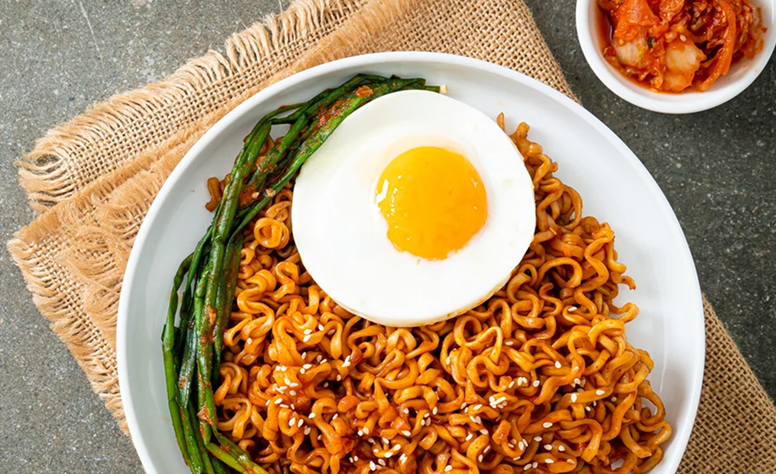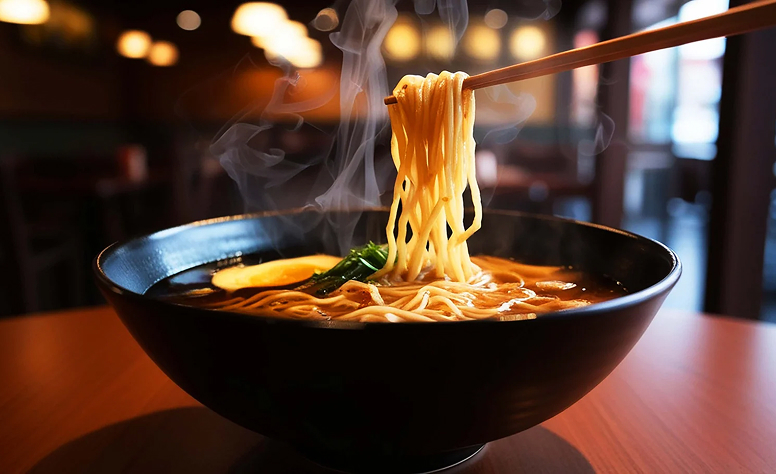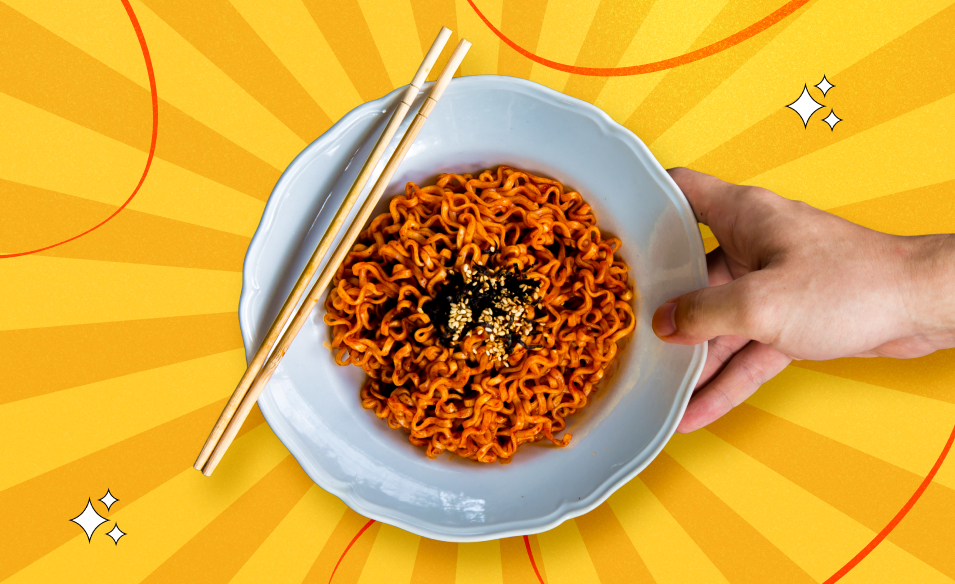Table Of Content
- What Is Korean Masala Ramen And Why Is It Popular In India?
- Can We Use Indian Masala To Make Korean Masala Ramen?
- Which Korean Noodle Brand Works Best For Masala Ramen?
- How To Make Fusion Korean Masala Ramen At Home?
- Non-Vegetarian Korean Masala Ramen Recipe
- Ingredients
- Instructions
- Vegetarian Korean Masala Ramen Recipe
- Ingredients
- Instructions
- Creamy Korean Masala Ramen Recipe
- Ingredients
- Instructions
- Spicy Korean Masala Ramen Recipe
- Ingredients
- Instructions
- What Toppings Can You Use For Korean Masala Ramen?
One dish that reminds me of my childhood (and I think its the case for most of us) is Maggi. Breakfast, snack, or even for lunch at school, this Indian noodle brand screams of nostalgia for most of us. Which is why I was pleasantly surprised when they decided to launch their Korean version.
I won’t lie, I was expecting a lot from this. But guess what? I was a little disappointed. But this made me think if Korean masala ramen with an Indian twist was something that I could turn to reality. And I sure did.
So, if you are in search of the perfect Korean masala ramen that can cure your hangover, or be your comforting partner to turn any day into a cozy one, I have you covered! Keep on reading till the end to get the recipe…
What Is Korean Masala Ramen And Why Is It Popular In India?

I kid you not when I say that this particular dish, which is a spicy, slurpy bowl of goodness, is the one thing that comforts me after a long, chaotic night.
Korean masala ramen is not your regular instant noodle fix. Rather, this dish is a beautiful fusion of Korea’s iconic ramyeon and India’s unapologetically bold masalas. The way the kick of gochugaru blends with a touch of garam masala, is nothing short of magic. At least that’s how I would like to explain it.
Korean masala ramen has exploded in popularity across India, especially among Gen Z and millennials who love experimenting in the kitchen. It’s quick, flavorful, and feels like comfort food but with a twist. The spicy-sweet-salty combo hits all the right notes for Indian taste buds, which already adore strong, layered flavors.
Apart from the fact that love for K-drama and the rise of Hallyu Wave is literally all over the country, social media, especially Instagram and YouTube, have also played a major role.
I won’t be lying if I say that I have come across at least hundreds of videos where home cooks and food influencers have made Korean-inspired dishes. And guess what? Korean-Indian fusion dishes like tteokbokki, kimchi fried rice, and masala ramen with an Indian twist have gone viral.
Can We Use Indian Masala To Make Korean Masala Ramen?
Yes, you can totally use Indian spices to make a spicy bowl of Korean masala ramen. And that’s where the fun begins. Korean ramen traditionally uses gochujang (Korean red chili paste), soy sauce, sesame oil, and sometimes a dash of sugar to balance the heat.
But if your pantry is more masala box than K-market, you can totally recreate that deep umami kick using Indian spices.
When I first tried it, I mixed leftover ramen noodles with my homemade curry masala and honestly, it was a game-changer. The flavors were spicier, smokier, and more desi.
So yes, Indian masalas not only work but can make your ramen uniquely flavorful and satisfying.
| Korean Ingredient | Indian Masala Alternative |
|---|---|
| Gochugaru | Kashmiri red chili powder |
| Gochujang | Mix of red chili paste + tomato ketchup + dash of soy sauce |
| Doenjang | A small spoon of thick dal tadka base or miso + turmeric |
| Soy sauce | Dark soy or Maggi seasoning sauce |
| Sesame oil | Mustard oil (used lightly) or ghee |
| Sugar or corn syrup | Jaggery powder |
| Korean curry powder | Indian curry powder or garam masala |
You see, the fusion that I am hinting towards is really not about following the rules. Rather, it is about hitting the right note that comforts you. So, irrespective of it’s a lazy Sunday lunch or your go-to hangover fix, Korean masala ramen made with Indian spices will always hit the spot.
Which Korean Noodle Brand Works Best For Masala Ramen?
Now that is a great question. When I made Korean masala ramen for the first time, I used whatever instant noodle pack was available at home. Yes, you guessed it right, it was Maggi. I have also made this noodle recipe with other Indian noodle brands like:
- Yippee!
- Top Ramen
- Wai Wai
But if you are trying to get the flavors a little more Korean (speaking authentically), here’s a list of Korean noodles that will work great:
- Nongshim Shin Ramyeon.
- Ottogi Jin Ramyeon.
- Samyang Buldak.
*Note: If you are trying to make the Korean masala ramen recipe a little more on the spicy side, it is best that you stick to Hot chicken flavor from the Samyang Buldak noodles range.
“Where will I get these Korean ingredients?” Well, there is no need for you to worry! You can get all these noodles at the various Korean marts which sell authentic ingredients and items that are imported straight from Korea.
How To Make Fusion Korean Masala Ramen At Home?

It is time for what you have been waiting for the ultimate Korean masala ramen recipe. I have added four versions. All of which I have tried.
Here’s the recipe that you need:
Non-Vegetarian Korean Masala Ramen Recipe
This one’s my go-to after a long night out spicy, meaty, and absolutely soul-soothing. It’s rich, flavorful, and has that umami depth that only chicken or prawns can bring.
Ingredients
- 1 pack of Korean ramen noodles (like Shin Ramyun or Samyang).
- 1 cup sliced chicken breast or prawns.
- 1tbsp chili oil.
- 1 tsp soy sauce.
- ½ tsp gochujang (or red chili paste + ketchup mix).
- 1 tsp ginger-garlic paste.
- 1 cup chicken stock or water.
- ½ onion, thinly sliced.
- ½ carrot, julienned.
- 1 egg (optional, for topping).
- ½ tsp sesame seeds.
- Spring onions for garnish.
Instructions
- In a pan, heat chili oil and sauté the ginger-garlic paste until fragrant.
- Add the sliced chicken or prawns and cook until golden and slightly crispy.
- Stir in onions and carrots, and sauté for another minute.
- Add soy sauce, gochujang, and chicken stock. Bring it to a simmer.
- Drop in the ramen noodles and cook for 3–4 minutes until soft.
- Crack an egg on top and let it poach gently in the broth (optional).
- Garnish with sesame seeds and spring onions.
- Serve hot ideally while binge-watching K-dramas or nursing a hangover.
*Personal Tip: Add a squeeze of lime for a tangy Indian kick that cuts through the spice perfectly.
Vegetarian Korean Masala Ramen Recipe
For days when you want something hearty but meat-free, this vegetarian Korean masala ramen hits just right. It’s warm, spicy, and full of crunchy veggies that soak up the flavors beautifully.
Ingredients
- 1 pack Korean ramen noodles.
- 1tbsp chili oil.
- ½ cup bell peppers, sliced.
- ½ cup cabbage, shredded.
- 1 tsp sesame seeds.
- 1 tsp ginger-garlic paste.
- ½ cup mushrooms, sliced.
- 1 tsp red chili paste (or gochujang).
- ½ tsp soy sauce.
- 1½ cups vegetable stock or water.
- Spring onions for garnish.
Instructions
- Heat chili oil in a wok and sauté the ginger-garlic paste until aromatic.
- Add all the veggies and stir-fry for 2–3 minutes.
- Stir in soy sauce, chili paste, and a pinch of salt.
- Pour in the vegetable stock and bring it to a simmer.
- Add the ramen noodles and cook until tender.
- Top with sesame seeds and spring onions.
- Serve piping hot with kimchi or pickled radish on the side.
*Personal Tip: I sometimes add a spoon of peanut butter to make it nutty and more filling — it’s the best lazy-Sunday comfort bowl.
Creamy Korean Masala Ramen Recipe
This one’s for when you want your ramen extra cozy and rich, think creamy, spicy, and velvety smooth. It’s like your hangover cure in a warm, buttery hug.
Ingredients
- 1 pack Korean ramen noodles.
- 1 cup milk or cream.
- 1tbsp chili oil.
- 1 tsp soy sauce.
- ½ tsp gochujang (or red chili paste + ketchup mix).
- 1tbsp butter.
- 1 tsp sesame seeds.
- ½ onion, finely chopped.
- 1 cup mushrooms or corn (optional).
- Salt to taste.
- Spring onions or coriander for garnish.
Instructions
- In a saucepan, melt butter and add chili oil.
- Add onions and sauté until soft.
- Mix in gochujang and soy sauce, cook for 30 seconds.
- Pour in milk or cream and stir until it simmers into a creamy broth.
- Add the ramen noodles and cook for 3–4 minutes until they absorb the flavor.
- Top with sesame seeds and garnish with spring onions.
- Serve warm and slurp your worries away.
*Personal Tip: For a cheesy twist, toss in a slice of cheese right before serving, it melts into the broth like magic!
Spicy Korean Masala Ramen Recipe
If your hangover needs a wake-up call, this fiery version will do the trick. It’s bold, peppery, and guaranteed to make you sweat (in the best way possible).
Ingredients
- 1 pack Korean ramen noodles.
- 1tbsp chili oil.
- 1 tsp sesame seeds.
- 1 tsp gochugaru (Korean chili flakes) or red chili powder.
- ½ tsp soy sauce.
- 1 tsp garlic paste.
- ½ tsp black pepper.
- 1½ cups water or stock.
- A dash of vinegar or lime juice.
- Optional: chopped green chilies for that Indian heat.
Instructions
- Heat chili oil in a pan and sauté the garlic paste.
- Add gochugaru (or red chili powder), soy sauce, and black pepper — stir well.
- Pour in water or stock and bring it to a boil.
- Drop in the ramen noodles and cook until perfectly soft.
- Add a dash of vinegar or lime juice for balance.
- Sprinkle sesame seeds and extra chili flakes before serving.
- Enjoy with a cold drink on the side because trust me, you’ll need it!
*Personal Tip: I sometimes toss in a boiled egg and a few drops of sesame oil for a rounder, richer finish.
What Toppings Can You Use For Korean Masala Ramen?
I don’t know about you, but I think choosing the right topping for a dish is as important as choosing the right ingredients for the same. While most people think that garnishing a dish is only about the way it looks, I think these ingredients also add flavor.
I mean, think about it: don’t we all like to scoop out the part where there is extra cream on top when we are having paneer butter masala or butter chicken? Or what about the freshly cut coriander leaves that adds color to our chicken korma? Does it not add taste?
Similarly, when you are cooking Korean masala ramen, you need to choose your toppings wisely. Here is my favorite list of toppings that you can use:
- Sesame seeds.
- Chili oil.
- Spring onions.
- Soft boiled eggs.
- Egg yolk (placed on top).
- Poached egg.
- Sunny side up.
- Cheese.
- Onion.
I hope you liked this blog. Try the recipe of your choice and let me know in the comments below!













